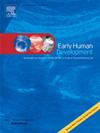Incidence, subtypes and severity of cerebral palsy in infants born extremely preterm in Switzerland: A retrospective study comparing two time periods
IF 2.2
3区 医学
Q2 OBSTETRICS & GYNECOLOGY
引用次数: 0
Abstract
Background
In 2011, the Swiss Society of Neonatology issued new guidelines for the care of preterm infants at the limit of viability leading to higher survival of infants born <28 weeks of gestation. It is unclear whether and how these recommendations affected the prevalence and severity of cerebral palsy (CP).
Objective
To investigate whether the prevalence, severity, and subtypes of CP in extremely preterm infants differ in two successive birth cohorts.
Methods
Retrospective, population-based analysis of prospectively collected data on infants born <28 weeks of gestation. CP prevalence, subtypes (Surveillance of cerebral palsy in Europe – SCPE classification), and severity (Gross Motor Function Classification System - GMFCS) assessed at 2 years corrected were compared between the two birth cohorts (2006–2011 and 2012–2017).
Results
Of 3244 registered infants, 2090 survived, of whom 1764 were followed up (84 %). Mortality was 38 % for the first period and 33 % for the second (p = 0.003) and 112 were diagnosed with CP. CP prevalence was 34.5 per 1000 live births (37.0 for 2006–2011 and 32.4 for birth-years 2012–2017, p = 0.476). A trend towards more bilateral spastic CP (2006–2011: 32 % and 2012–2017: 50 %, p = 0.055) and more severe cases (2006–2011: 14.3 % and 2012–2017: 24.9 %, p = 0.154) was observed in the second period. CP severity was associated with cystic periventricular leukomalacia (PVL) (OR 3.4, 95 %-CI 1.1–10.3, p = 0.033) and necrotizing enterocolitis (NEC) (OR 5.5, 95 % CI 1.2–25.1, p = 0.028) but not with other neonatal morbidities.
Conclusion
These results suggest that the greater number of bilateral forms and severe cases of CP could be due to the higher number of surviving infants in the 2011–2017 cohort. PVL and NEC are the factors mostly associated with severe cases of CP in Switzerland.
瑞士极早产婴儿脑瘫的发病率、亚型和严重程度:一项比较两个时期的回顾性研究
2011年,瑞士新生儿学会发布了新的生存能力极限早产儿护理指南,该指南可提高妊娠28周出生婴儿的存活率。目前尚不清楚这些建议是否以及如何影响脑瘫的患病率和严重程度。目的探讨两个连续出生队列中极早产儿CP的患病率、严重程度和亚型是否存在差异。方法对妊娠28周出生的新生儿进行回顾性、基于人群的前瞻性分析。比较两个出生队列(2006-2011年和2012-2017年)的CP患病率、亚型(欧洲脑瘫监测- SCPE分类)和严重程度(大运动功能分类系统- GMFCS)。结果3244例患儿中,存活患儿2090例,随访患儿1764例(84%)。第一期死亡率为38%,第二期死亡率为33% (p = 0.003), 112人被诊断为CP。CP患病率为每1000例活产34.5例(2006-2011年为37.0例,2012-2017年为32.4例,p = 0.476)。第二阶段观察到双侧痉挛性CP(2006-2011年:32%,2012-2017年:50%,p = 0.055)和更严重的病例(2006-2011年:14.3%,2012-2017年:24.9%,p = 0.154)的趋势。CP严重程度与囊性脑室周围白质软化症(PVL) (OR 3.4, 95% -CI 1.1-10.3, p = 0.033)和坏死性小肠结肠炎(NEC) (OR 5.5, 95% CI 1.2-25.1, p = 0.028)相关,但与其他新生儿疾病无关。结论这些结果表明,2011-2017年队列中幸存的婴儿数量较多可能是双侧形式和严重CP数量较多的原因。PVL和NEC是瑞士严重CP病例的主要相关因素。
本文章由计算机程序翻译,如有差异,请以英文原文为准。
求助全文
约1分钟内获得全文
求助全文
来源期刊

Early human development
医学-妇产科学
CiteScore
4.40
自引率
4.00%
发文量
100
审稿时长
46 days
期刊介绍:
Established as an authoritative, highly cited voice on early human development, Early Human Development provides a unique opportunity for researchers and clinicians to bridge the communication gap between disciplines. Creating a forum for the productive exchange of ideas concerning early human growth and development, the journal publishes original research and clinical papers with particular emphasis on the continuum between fetal life and the perinatal period; aspects of postnatal growth influenced by early events; and the safeguarding of the quality of human survival.
The first comprehensive and interdisciplinary journal in this area of growing importance, Early Human Development offers pertinent contributions to the following subject areas:
Fetology; perinatology; pediatrics; growth and development; obstetrics; reproduction and fertility; epidemiology; behavioural sciences; nutrition and metabolism; teratology; neurology; brain biology; developmental psychology and screening.
 求助内容:
求助内容: 应助结果提醒方式:
应助结果提醒方式:


